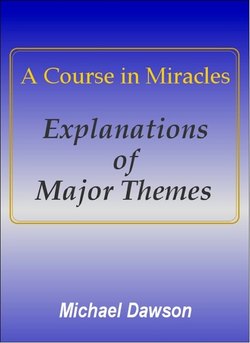Читать книгу A Course in Miracles - Explanations of Major Themes - Michael Dawson - Страница 6
На сайте Литреса книга снята с продажи.
What 'A Course in Miracles' Is
ОглавлениеReprinted from Healing the Cause
Much of the material in this book is based upon my understanding of some of the principles of the Course. I have included below some introductory material about what the Course says.
It is a book about how to heal our minds, for this is where the source of all our physical and psychological suffering lies. The aim of the Course is for us to achieve a state of inner peace, a quiet joy, no matter what we are doing, who we are with, or where we may be. It does this by teaching us a new way of looking at the world. This change of perception is the miracle — hence the title of the book.
The Course teaches that everything in this world can be used as a mirror to what we believe. Our relationships are the most powerful of all our mirrors. By relationships I mean all forms: lovers, parent and child, therapist and client, employer and employee, friends, etc. A relationship is an extremely powerful way of bringing into our awareness what needs to be healed within our mind. The Course teaches that through forgiveness and turning within for help, we can undo all the guilt we carry. This guilt originates from the false belief in our unconscious mind that we have willed to separate ourself from God, and have succeeded in this attempt. Chapter 2 will explore this theme more fully. Guilt is the term the Course uses to describe our self-hate, feelings of inferiority, lack of self-worth and all the negative beliefs we have about ourself. As we learn to undo our guilt, the memory of God’s love for us will return to our mind. When we re-experience the unconditional love of God, everything in this world will lose its appeal, including our identification with our body. (See Figure 1.1)
The Course is a unique blend of modern psychology, radical metaphysics and deep spiritual truths. Much of the psychology echoes Sigmund Freud’s teachings on our ego defence mechanisms of denial and projection and will be explained further in Chapter 3. The three volumes comprising the Course are a lifetime study requiring much re-reading to benefit from the depths of its teachings. The metaphysics of the Course have many parallels with some Eastern philosophies and religions. There are over 700 references to the Bible, and Jesus often reinterprets these biblical sayings. Many Christian terms are used in the Course but with entirely different meanings. Jesus stresses that we are not guilty, sinful creatures who need to atone through sacrifice and suffering. Instead, he gives us the inspiring message that we are guiltless, sinless creations of God who have fallen asleep in Heaven. In our collective dream, we have forgotten the abstract eternal beauty of our real nature and believe we are bodies in a world of form.
The Course is not trying to convince us that it is the only spiritual path. It states that it is but one of ‘many thousands’ of spiritual paths and that other teachers with different symbols are also needed. (M3; M-1.4:1-2)
Jesus often says that the message of his Course is simple. However, when we first start to study it, it does not appear that way to most of us. This is because the Course’s thought system is completely opposite to our ego’s way of looking at the world. The Course uses the term ‘ego’— as is also the practice in the East — to describe our ‘little self’ which we have made to try to take the place of our real Self which God created. Our ego identifies with our body whilst our Self (or Christ nature) knows only the truth of our formless, spiritual magnificence.
Jesus stresses that all God’s children, referred to in the Course as the Son, Sonship or Christ, were created equal. Thus Jesus is not especially favoured in God’s eyes but is equal with all of us. He simply awoke to his true reality before us and seeks to help us regain what we have forgotten. In later chapters I will expand on some of the Course’s teachings, especially with regard to healing our mind.
The Text in particular seems hard to grasp and the practice of forgiveness equally difficult. Because of this some people tend to read only the Workbook. However, there is much material in the Text, especially concerning relationships, which is not found in the Workbook. The Text forms the theoretical foundation of the Workbook. It becomes very easy to misunderstand the Workbook and read its message out of context without a knowledge of the theoretical framework of the Course which is found in the Text. On the other hand, to study the Text but not apply it through the Workbook lessons is to end up with an ungrounded and abstract view of the Course. Yet, with time, the message of the Course does become simple, although never easy to apply. 'Victim consciousness' is ingrained in our psyches and the desire to blame others for our unhappiness is universal. To read in the Course (see first quotation on page 13) that no one can take away our peace, only ourselves, is a difficult message to accept, but one which will eventually lead us to happiness.
See also 'Introduction to A Course in Miracles'' from the Foundation for Inner Peace and "What it is" from the Preface of A Course in Miracles.
